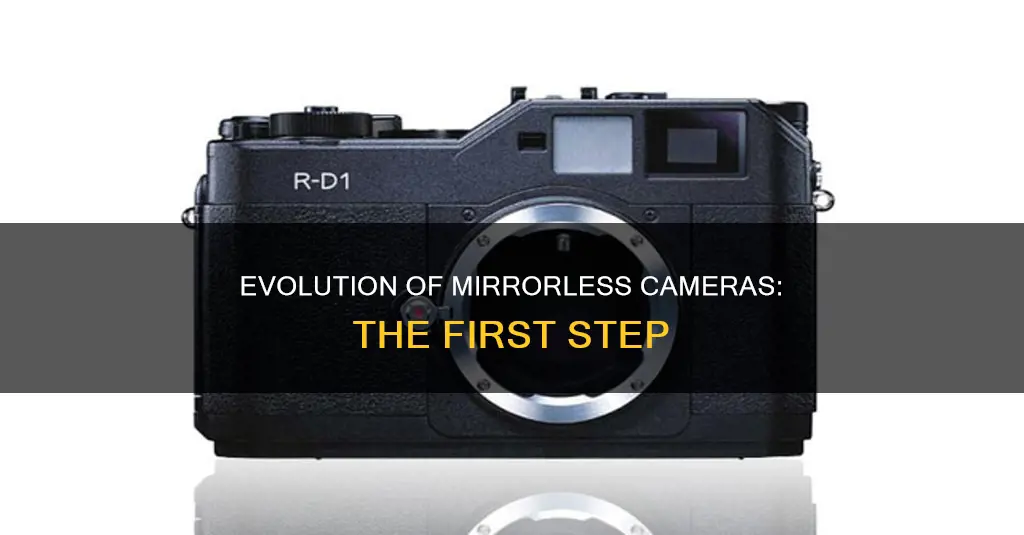
The first mirrorless camera was the Epson R-D1, released in 2004. It was a digital rangefinder camera with interchangeable lenses, and it retailed for almost $3,000. While some argue that the Epson R-D1 and similar early cameras with interchangeable lenses, such as the 2006 Leica M8, were not true mirrorless cameras due to their optical finders, the Epson R-D1 is still considered the first of its kind and played a crucial role in the development of mirrorless technology.
| Characteristics | Values |
|---|---|
| Year the first mirrorless camera was made | 2004 |
| Company that made the first mirrorless camera | Epson |
| Model of the first mirrorless camera | R-D1 |
What You'll Learn

The Epson R-D1 was the first mirrorless camera
The Epson R-D1 was the first commercially available mirrorless camera, released in 2004. At the time, it was not marketed as a mirrorless camera, but rather a rangefinder. However, it did have the sensor located in front of the lens, which is a defining feature of mirrorless cameras.
The Epson R-D1 was a groundbreaking innovation in the world of photography. It was the first digital rangefinder camera with interchangeable lenses, developed in partnership with Cosina. This premium camera was highly regarded for its time and featured a manual film winder to prepare the shutter for the next shot. With a price point of almost $3,000, it was a very high-end, niche product.
The R-D1 had a 6.1-megapixel APS-C sensor, 200-1,600 ISO range, 1:1 optical viewfinder, and a 2.5-inch fixed LCD. It took Leica M-mount lenses, which further added to its appeal. Despite its hefty price tag, the Epson R-D1 was a pioneer in the mirrorless camera space, setting the stage for future developments in this field.
The release of the Epson R-D1 marked a significant milestone in the evolution of mirrorless cameras. It inspired other companies to enter the market and sparked the creation of new formats for interchangeable lens mirrorless cameras. The R-D1's impact extended beyond its technical specifications, as it paved the way for the Micro Four Thirds (MFT) format, which was launched by Panasonic and Olympus in 2008. This format aimed to offer significantly slimmer cameras without compromising on image quality.
In conclusion, the Epson R-D1 holds a notable place in the history of mirrorless cameras. Its introduction in 2004 marked the beginning of a new era, challenging traditional DSLR cameras and shaping the future of photography. The R-D1's influence extended beyond its time, as it inspired innovation and pushed the boundaries of what mirrorless cameras could achieve.
Battery-Powered Wi-Fi Cameras: Night Vision Included?
You may want to see also

Released in 2004, it was a premium product
The first mirrorless camera was released by Epson in 2004. The Epson R-D1 was a premium product with a price tag of $3,000, making it a high-end, niche product. It was a digital rangefinder camera with interchangeable lenses, developed in partnership with Cosina. The camera featured a manual film winder to prepare the shutter for the next shot and could take Leica M-mount lenses.
The Epson R-D1 was a groundbreaking innovation in the world of photography, paving the way for the mirrorless cameras we know today. It was the first of its kind, combining emerging technology with a retro look and feel. The camera's specifications were impressive for its time, and it was highly regarded by photographers and enthusiasts.
The R-D1's release marked a significant milestone in the evolution of camera technology. It demonstrated the potential of mirrorless cameras and inspired other manufacturers to enter the market. The R-D1's impact extended beyond the initial launch, as it laid the foundation for future advancements and the development of new formats for interchangeable lens mirrorless cameras.
The release of the Epson R-D1 in 2004 was a pivotal moment in the history of mirrorless cameras. Its premium features and performance set a new standard and paved the way for the advancements and innovations that have shaped the mirrorless camera market today.
Battery Chargers: Are They Included With Cameras?
You may want to see also

The Leica M8 was the second mirrorless camera
The first true consumer mirrorless camera was the Epson R-D1, released in 2004. The Leica M8, released in 2006, was the second mirrorless camera.
The Leica M8 was the first digital camera in the rangefinder M series introduced by Leica Camera AG. It featured a 10.3-megapixel APS-H sensor, 800-2,500 ISO, and a max shutter speed of 1/8,000 of a second. The M8's body was all-metal, made of a high-strength magnesium alloy, with top and base plates cut from brass billets. The camera was priced at $5,500 at launch.
The M8 suffered from some controversy on its release due to image quality problems reported by some users, particularly an extremely high sensitivity to infrared light, which made black colours appear purple. Leica addressed this issue by offering two free special UV/IR screw-on photographic filters to all M8 purchasers.
The M8 inspired the creation of multiple new formats for interchangeable lens mirrorless cameras, the most important being Micro Four Thirds (MFT), which was launched by Panasonic and Olympus in 2008. The M8 laid down the basic pattern for the cameras that came after it, while remaining true to its film roots.
Unlocking Camera Mode in Smash Melee: A Step-by-Step Guide
You may want to see also

Panasonic's DMC-G1 kickstarted the mirrorless movement
The first true mirrorless camera was the Epson R-D1, released in 2004. However, it was Panasonic's DMC-G1 that kickstarted the mirrorless movement. Released in 2008, the DMC-G1 was the first product of the new M4/3 standard developed by Panasonic and Olympus. The M4/3 system was a further development of the 4/3 standard, which was based on DSLR technology.
The DMC-G1 was a well-received and specified camera. It offered a 12.1MP image sensor, a maximum sensitivity of ISO3200, and a top continuous shooting speed of 3fps. It also featured a 23-zone contrast-detect autofocus system, an electronic viewfinder, and a fully articulating screen.
The DMC-G1 was significantly smaller and lighter than its contemporary DSLRs, and its success led to the release of numerous other cameras in the format by both Olympus and Panasonic. This kickstarted the mirrorless movement, and today, mirrorless cameras are here to stay.
While the Epson R-D1 and the Leica M8, released in 2006, were the first interchangeable lens cameras without mirrors, they still featured optical finders rather than being dedicated live view devices. As such, the Panasonic DMC-G1 is considered by some to be the first true mirrorless camera.
How to Rehearse Slideshows with Camera Access
You may want to see also

Sony's Alpha 7 series signalled the true arrival of the mirrorless system
The first mirrorless camera was released in 2008, the Panasonic Lumix G1. However, it was Sony's Alpha 7 series that signalled the true arrival of the mirrorless system. On October 16, 2013, Sony announced the Alpha 7 and Alpha 7R, the world's smallest and lightest full-frame mirrorless interchangeable lens cameras.
The Alpha 7 series brought an unmatched combination of creativity, customisability, and portability to the scene. The Alpha 7 featured a 24.3-megapixel full-frame Exmor CMOS sensor, while the Alpha 7R boasted a 36.4-megapixel Exmor CMOS sensor, the highest resolution sensor in Sony's Alpha line at the time. Both cameras offered speedy and accurate autofocus systems and continuous shooting capabilities, making them exciting options for photographers capturing fast-action subjects like sports and wildlife.
The release of the Alpha 7 series marked a significant shift in the camera industry, as Sony forged ahead with its innovation in mirrorless technology. The series' success and the positive reception from critics and industry experts solidified the mirrorless camera's place in the market. This was further reinforced by Sony's continuous development of new mirrorless camera models and technologies based on user feedback and evolving creator needs.
In the years following the Alpha 7 and 7R's release, Sony expanded its mirrorless camera lineup with new models, such as the Alpha 7S, Alpha 7 II, and Alpha 7R II, each offering enhanced features and improved performance. The Alpha 7 series' impact extended beyond Sony, with other camera manufacturers also investing in mirrorless technology and releasing their own full-frame mirrorless cameras.
Today, mirrorless cameras have become ubiquitous, offering image quality rivaling that of DSLRs, and providing photographers and videographers with lightweight, versatile tools for their craft.
Charging Your Fujifilm Waterproof Camera: A Step-by-Step Guide
You may want to see also
Frequently asked questions
The first mirrorless camera was released in 2004 by Epson. It was called the R-D1 and was a digital rangefinder camera with interchangeable lenses.
Some people don't consider the Epson R-D1 to be a true mirrorless camera as it featured an optical finder rather than being a dedicated live view device.
The Panasonic Lumix G1, released in 2008, is considered by some to be the first true mirrorless camera.
The Leica M8, released in 2006, was Leica's first mirrorless interchangeable lens camera. The Sony NEX-3 and NEX-5, released in 2010, were also early mirrorless interchangeable lens cameras that contributed to the development of the market.







